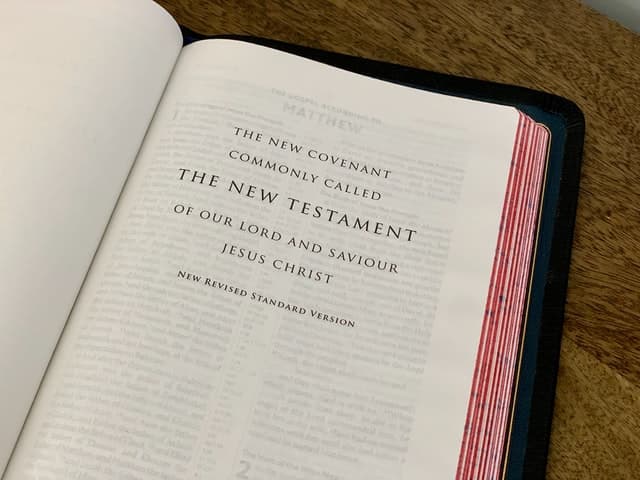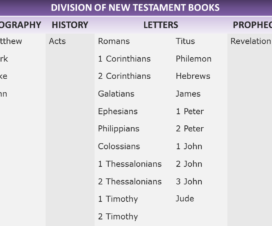 The New Testament is the part of the Christian Bible that tells about Jesus and contains letters written by the apostles and other early Christians.
The New Testament is the part of the Christian Bible that tells about Jesus and contains letters written by the apostles and other early Christians.
The New Testament—written by Jesus’ followers some 2,000 years ago—includes four accounts of His life (the Gospels) and letters from early Christians describing their beliefs about how they should follow Him after his death.
New Testament definition
The New Testament is a collection of 27 books that were written by Jesus’ apostles after He died and came back to life. These writings tell us what happened during Jesus’ ministry, how Christianity spread across the world, and also serve as a witness for His resurrection from death.
We divide the New Testament into two sections—the Gospels and Epistles.
The Gospels are the first four books of the New Testament, and they tell us about Jesus—why He came to save us from our sins and how He did it. The Gospels also promise that if we listen to Jesus, He will send another Person—the Holy Spirit—to teach us everything else.
The Epistles are the letters that were written by Paul, Peter, and others after Jesus’ death. Through these writings we can understand Christianity more fully in our lives today.
The last book of the Bible is called Revelation, also known as The Apocalypse. It describes visions received by John while he was exiled on an island for his faith in Christ.
What is the difference between the Old and New Testaments?
The Old Testament and the New Testament are key parts of the Bible, which tells a grand story about how God loves all people.
God’s people wrote about their experiences with God, as well as their understanding of His teachings and miracles—to help others understand how He works in our lives today. But what is the difference between these two things?
- The Old Testament was written by Israelites, God’s chosen people. He sent them prophets to teach them about Himself so they could know Him better—and gave Moses laws that would help lead the Israelites away from their pagan ways.
- The New Testament was written by followers of Jesus after His death, resurrection, and ascension. The books tell about Jesus’ life on earth and the apostles’ ongoing ministry to spread Christ’s teachings.
Who wrote the NT?
The New Testament was written by men who were inspired by God, but they weren’t infallible. They had their own opinions and biases—just like we do today—but we expect them to be honest and accurate.
The writers of the New Testament were eyewitnesses who had been ordained by Jesus himself as apostles (Luke 1:1-4).
The identity of the New Testament writers is further confirmed by historical accounts and the Dead Sea Scrolls. They were not anonymous; they put their names to their words.
Many of them died for their faith or suffered from their tormentors. We have no reason to doubt who wrote them.
- Matthew was a tax collector as a Jew from Galilee who had heard Jesus preach many times before he became one of His disciples (Matthew 9:9).
- Mark was another disciple of Jesus who lived in Rome with Peter during Paul’s second missionary journey (Acts 12:12).
- Luke was likely a Gentile convert who traveled with Paul during his preaching tours throughout Europe and Asia Minor (Colossians 4:14).
- John, son of Zebedee, was the youngest of Jesus’ twelve apostles.
- The Apostle Paul, also called Paul (13 letters), is the son of a pharisee who persecuted Christians before converting to Christianity. He was born in Tarsus, a Roman province, and educated as a Roman citizen.
- The Apostle Peter (2 letters) – Simon Peter, one of Jesus’ disciples and Church leaders. He is known for his role as an apostle—the first person to follow Jesus personally—and for founding the Catholic Church by preaching about salvation.
- James (2 letters) – James was one of Jesus’ twelve disciples. After the resurrection, he and his brother John led the church in Jerusalem and were considered to be pillars of Christianity by some scholars.
- John (3 letters) — also known as “John the Apostle” or “John the Evangelist”— was one of Jesus’ twelve disciples.
- The Letter of Jude is also found in the New Testament, and it is the only letter to be written by a relative of Jesus.
- Many Christians believe that Saint John the Apostle wrote Revelation, but other scholars dispute this claim because there is no biblical evidence for it.

In what language is the New Testament written?
It was called Koine because it was the common language spoken throughout the Hellenic (Greek) world, from Greece itself to Egypt and Palestine.
Because it was a common dialect spoken throughout the Mediterranean world, Koine Greek came to be known as “common Greek.”
Some parts of the New Testament were also written in Aramaic, a common language at that time. It is closely related to Hebrew and shares many similarities with it—for example, Jesus often spoke Aramaic during his life on earth (Matthew 27:46).
Some Hebrew was also spoken by some Jews in Judea and Galilee during this period.
Besides Greek and Hebrew, Latin was also used by early Christians. Many early Christian writers wrote in Latin because it was more widely understood than Greek or Hebrew. Early church theologians, such as Augustine of Hippo (354–430 CE) wrote extensively on theology in Latin.
What is the primary message of the New Testament?
The word “testament” means “covenant or agreement.”
- The Old Testament contained a covenant agreement made between God and His people—the Jews—who lived in Israel.
- But the New Testament contains an agreement that God has made with all people through Jesus’ death on the cross and resurrection from the dead. This new covenant promises salvation (deliverance) from sin and eternal life in heaven for all who believe in Jesus Christ as Lord and Savior.
The principal message of the New Testament is this:
- God loves us so much that He sent His Son, Jesus Christ, into this world as our Savior from sin (1 John 4:9).
- Jesus died on the cross to pay for our sins, allowing us to be forgiven if we repent of our sins and trust in Him as our Savior (John 1:12).
- He rose again three days later in victory over sin and death so that we would have eternal life with Him if we believe in Him (1 Corinthians 15:1-4).
The NT’s four major sections
The Gospels are books that tell the story of Jesus’ life and ministry. They are Matthew, Mark, Luke, and John.
Acts is a book about the early church written by Luke—a companion to Paul who also wrote one gospel account.
The letters of Paul and other early Christian leaders were written to different churches in the mid-first century AD. They include Romans, I Corinthians, II Corinthians, Galatians , Ephesians (and more) .
Revelation is the final book of the New Testament, and its descriptions of future events are considered prophetic.
What is a good order to read the New Testament?
In the end, every Christian will have their own opinion on this matter. Some people prefer to read the Gospels followed by the Epistles, while others enjoy reading from Paul’s letters first—and then move on to Jesus’ stories. As long as you’re reading and understanding God’s word for yourself, it doesn’t matter so much what order you follow!
There are many ways to read through the New Testament, or any other book for that matter. It’s a matter of preference and what will work best given your time constraints and goals—but I think it’s good to start with Mark.
If you are looking for insight into the nature of Christianity, I would suggest reading Paul’s letters first, followed by those of Peter and James.
This will enable you to see how Jesus’ teachings influenced Paul, and then compare them with the writings of those who worked closely with him.
- If your purpose is to learn about Jesus, then there’s no reason you shouldn’t start with John’s Gospel and work your way through Acts.
- Or if your main interest is God’s plan of salvation revealed in Christ, then you’ll probably want to start with Romans and work your way through Revelation.
The Bible is not a novel, it’s a collection of books written by different authors over many years. As such, there’s no one “right order” to read them in.
Conclusion
The first four books are narratives, telling stories about the life and teachings of Christ and the Christian church during this period. These are followed by wisdom, apocalyptic, and epistolary books.
I believe we are living in the last days, when Jesus said that the gospel would be preached to all nations before the end.
I think Jesus had to mean the New Testament because we know that the gospel was not preached to all nations at that time. The apostle Paul said in Romans 15:21,
“They shall see who have never been told of Him, and they shall understand who have never heard of Him.”



